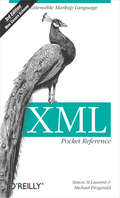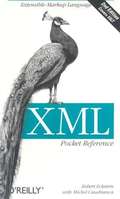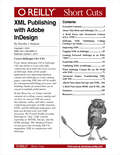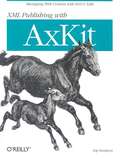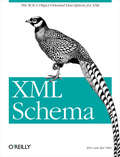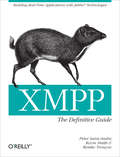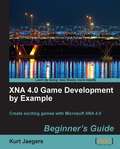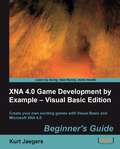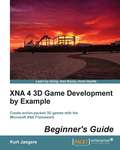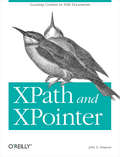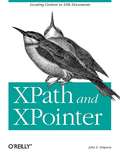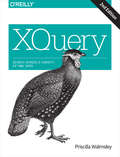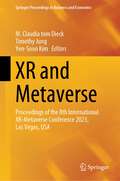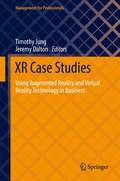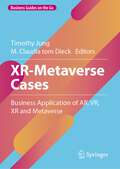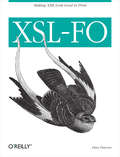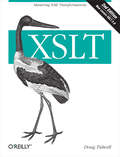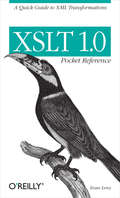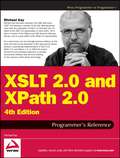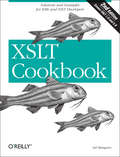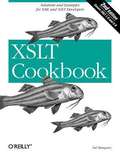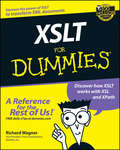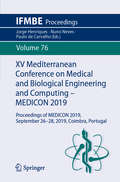- Table View
- List View
XML Pocket Reference: Extensible Markup Language (Pocket Reference (O'Reilly))
by Simon St. Laurent Michael FitzgeraldXML, the Extensible Markup Language, is everywhere: the syntax of choice for newly designed document formats across almost all computer applications. Now used daily by developers, XML is living up to its reputation as one of the most important developments in document interchange in the history of computing. A perennial bestseller, the handy XML Pocket Reference from O'Reilly has been revised once again to give you quick access to the latest goods. In addition to its comprehensive look at XML, this third edition has been updated with new material on Namespaces and XML Schema--considered among the most important elements in current XML use--along with RELAX NG and Schematron, additional powerful tools for describing XML document structures. Like other titles in O'Reilly's Pocket Reference series, the XML Pocket Reference, 3rd Edition features a well-organized format that gets right to the point. As a result, it's already won over the allegiance of developers everywhere. If you need XML answers quick and on the fly, this compact book is most definitely the book for you.
XML Pocket Reference, 2nd Edition
by Robert EcksteinThe XML Pocket Referenceis both a handy introduction to XML terminology and syntax, and a quick reference to XML instructions, attributes, entities, and datatypes. Although XML itself is complex, its basic concepts are simple. This small book combines a perfect tutorial for learning the basics of XML with a reference to the XML and XSL specifications. The new edition introduces information on XSLT (Extensible Stylesheet Language Transformations) and Xpath.
XML Publishing with Adobe InDesign
by Dorothy HoskinsFrom Adobe InDesign CS2 to InDesign CS5, the ability to work with XML content has been built into every version of InDesign. Some of the useful applications are importing database content into InDesign to create catalog pages, exporting XML that will be useful for subsequent publishing processes, and building chunks of content that can be reused in multiple publications. In this Short Cut, we'll play with the contents of a college course catalog and see how we can use XML for course descriptions, tables, and other content. Underlying principles of XML structure, DTDs, and the InDesign namespace will help you develop your own XML processes. We'll touch briefly on using InDesign to "skin" XML content, exporting as XHTML, InCopy, and the IDML package. The Advanced Topics section gives tips on using XSLT to manipulate XML in conjunction with InDesign.
XML Publishing with AxKit
by Kip HamptonWeb developers rely on XML to separate data from presentation and create a consistent templating system for a web site. Although limited XML-to-HTML conversion is possible within some browsers, web developers creating dynamic or complex sites will find server-side XML transformation a necessity. Unfortunately, until recently, there have been few XML tools available for server-side XML transformation or authoring. AxKit, a mod_perl and Apache-based XML content delivery solution, was designed to meet that need with a cost-effective and efficient plugin architecture. AxKit allows the developer to quickly design modules to create faster web sites, and deliver them in a wide variety of media formats. AxKit also takes care of caching so the developer doesn't have to worry about it. AxKit meets the demands of the web developer nicely, but, as with any new toolkit, there is a learning curve. For developers who want to flatten that learning curve and get right to work with AxKit, XML Publishing with AxKit provides detailed information on how to install, configure, and deploy AxKit effectively. The first book solely devoted to AxKit, XML Publishing with AxKit also offers a concise and focused look at how to create XSLT and XPathScript-based pipelines for XML data transfer. This solidly useful new book presents web programmers with the hands-on knowledge they need to get really creative with AxKit. It features a thorough introduction to XSP (extensible Server Pages), which applies the concepts of Server Pages technologies (embedded code, tag libraries, etc) to the XML world, and covers integrating AxKit with other tools such as Template Toolkit, Apache:: Mason, Apache::ASP, and plain CGI. The book also includes invaluable reference sections on configuration directives, XPathScript, and XSP. With XML Publishing with AxKit , web developers will have all the tools they need to deliver complex XML-based systems quickly, the power to develop their own systems for style sheet negotiation, and the flexibility to design completely new style sheet languages. XML Publishing with AxKit gives those new to XML all the background and the courage they need to jump right in and deploy AxKit. And it gives XML-savvy professionals everything they need to hit the ground running.
XML Schema
by Eric van der VlistIf you need to create or use formal descriptions of XML vocabularies, the W3C's XML Schema offers a powerful set of tools for defining acceptable document structures and content. An alternative to DTDs as the way to describe and validate data in an XML environment, XML Schema enables developers to create precise descriptions with a richer set of datatypes?such as booleans, numbers, currencies, dates and times?that are essential for today?s applications. Schemas are powerful, but that power comes with substantial complexity. This concise book explains the ins and outs of XML Schema, including design choices, best practices, and limitations. Particularly valuable are discussions of how the type structures fit with existing database and object-oriented program contexts. With XML Schema, you can define acceptable content models and annotate those models with additional type information, making them more readily bound to programs and objects. Schemas combine the easy interchange of text-based XML with the more stringent requirements of data exchange, and make it easier to validate documents based on namespaces. You?ll find plenty of examples in this book that demonstrate the details necessary for precise vocabulary definitions. Topics include: Foundations of XML Schema syntax Flat, "russian-doll", and other schema approaches Working with simple and complex types in a variety of contexts The built-in datatypes provided by XML Schema Using facets to extend datatypes, including regular expression-based patterns Using keys and uniqueness rules to limit how and where information may appear Creating extensible schemas and managing extensibility Documenting schemas and extending XML Schema capabilities through annotations In addition to the explanatory content, XML Schemaprovides a complete reference to all parts of both the XML Schema Structures and XML Schema Datatypes specifications, as well as a glossary. Appendices explore the relationships between XML Schema and other tools for describing document structures, including DTDs, RELAX NG, and Schematron, as well as work in progress at the W3C to more tightly integrate XML Schema with existing specifications. No matter how you intend to use XML Schema - for data structures or document structures, for standalone documents or part of SOAP transactions, for documentation, validation, or data binding ? all the foundations you need are outlined in XML Schema.
XMPP: Building Real-Time Applications with Jabber Technologies
by Peter Saint-Andre Kevin Smith Remko TronçonThis practical book provides everything you need to know about the Extensible Messaging and Presence Protocol (XMPP). This open technology for real-time communication is used in many diverse applications such as instant messaging, Voice over IP, real-time collaboration, social networking, microblogging, lightweight middleware, cloud computing, and more. XMPP: The Definitive Guide walks you through the thought processes and design decisions involved in building a complete XMPP-enabled application, and adding real-time interfaces to existing applications. You'll not only learn simple yet powerful XMPP tools, but you'll also discover, through real-world developer stories, how common XMPP "building blocks" can help solve particular classes of problems. With this book, you will: Learn the basics of XMPP technologies, including architectural issues, addressing, and communication primitives Understand the terminology of XMPP and learn about the wealth of XMPP servers, clients, and code libraries Become familiar with the XMPP concepts and services you need to solve common problems Construct a complete business application or real-time service with XMPP Every day, more software developers and service providers are using XMPP for real-time applications, and with the help of XMPP: The Definitive Guide, you can, too.
XNA 4.0 Game Development by Example: Beginner's Guide
by Kurt JaegersThis book is a step-by-step tutorial that includes complete source code for all of the games covered. It adopts an engaging style to teach all the game development concepts. Each block of code is explained, and game development concepts are diagrammed and covered in detail. Each game begins with a concept description and concludes with suggestions for expanding on the finished game. If you are an aspiring game developer who wants to take a shot at creating games for the Microsoft Windows platform with the XNA Framework, then this book is for you. Using this book, you can get started with creating games without any game development experience. A basic knowledge of C# would be helpful to kick-start your game development, but it's not essential.
XNA 4.0 Game Development by Example: Beginner's Guide – Visual Basic Edition
by Kurt JaegersThis book is a step-by-step tutorial that includes complete source code for all of the games covered. It adopts an engaging style to teach all the game development concepts. Each block of code is explained, and game development concepts are diagrammed and covered in detail. Each game begins with a concept description and concludes with suggestions for expanding on the finished game. If you are an aspiring game developer who wants to take a shot at creating games for the Microsoft Windows platform with the XNA Framework, then this book is for you. Using this book, you can get started with creating games without any game development experience. A basic knowledge of Visual Basic would be needed to kickstart your game development.
XNA 4 3D Game Development by Example: Beginner's Guide
by Kurt JaegersThis book is a step-by-step tutorial that includes complete source code for all of the games covered. It adopts an engaging style to teach all the game development concepts. Each block of code is explained, and game development concepts are diagrammed and covered in detail. Each game begins with a concept description and concludes with suggestions for expanding on the finished game. This book is intended for readers who want to create 3D games using the XNA Framework. Basic knowledge of the C# programming language and 2D XNA concepts are helpful, but not required.
XPath and XPointer
by John SimpsonReferring to specific information inside an XML document is a little like finding a needle in a haystack: how do you differentiate the information you need from everything else? XPath and XPointer are two closely related languages that play a key role in XML processing by allowing developers to find these needles and manipulate embedded information. XPath describes a route for finding specific items by defining a path through the hierarchy of an XML document, abstracting only the information that's relevant for identifying the data. XPointer extends XPath to identify more complex parts of documents. The two technologies are critical for developers seeking needles in haystacks in various types of processing. XPath and XPointer fills an essential need for XML developers by focusing directly on a critical topic that has been covered only briefly. Written by John Simpson, an author with considerable XML experience, the book offers practical knowledge of the two languages that underpin XML, XSLT and XLink. XPath and XPointer cuts through basic theory and provides real-world examples that you can use right away. Written for XML and XSLT developers and anyone else who needs to address information in XML documents, the book assumes a working knowledge of XML and XSLT. It begins with an introduction to XPath basics. You'll learn about location steps and paths, XPath functions and numeric operators. Once you've covered XPath in depth, you'll move on to XPointer--its background, syntax, and forms of addressing. By the time you've finished the book, you'll know how to construct a full XPointer (one that uses an XPath location path to address document content) and completely understand both the XPath and XPointer features it uses. XPath and XPointer contains material on the forthcoming XPath 2.0 spec and EXSLT extensions, as well as versions 1.0 of both XPath and XPointer. A succinct but thorough hands-on guide, no other book on the market provides comprehensive information on these two key XML technologies in one place.
XPath and XPointer
by John E. SimpsonReferring to specific information inside an XML document is a little like finding a needle in a haystack. XPath and XPointer are two closely related languages that play a key role in XML processing by allowing developers to find these needles and manipulate embedded information. By the time you've finished XPath and XPointer , you'll know how to construct a full XPointer (one that uses an XPath location path to address document content) and completely understand both the XPath and XPointer features it uses.
XQuery
by Priscilla Walmsley<p><em>XQuery</em> delivers a carefully paced tutorial that goes into the final 1.0 standard in detail. The book delves into critical advanced issues such as data typing and designing efficient query logic. Whether you're coming from SQL, XSLT, or starting from scratch, you'll learn about XQuery's support for filtering, sorting, and grouping data, as well as how to use FLWR expressions, XPath, and XQuery tools for extracting and combining information.</p>
XR and Metaverse: Proceedings of the 8th International XR-Metaverse Conference 2023, Las Vegas, USA (Springer Proceedings in Business and Economics)
by M. Claudia tom Dieck Timothy Jung Yen-Soon KimThis book offers a comprehensive collection of the latest research presented at the 8th International XR-Metaverse Conference, held in Las Vegas, USA in 2023. Its goal is to bridge the gap between academia and industry by advancing the state of the art in metaverse, XR, AI-based AR and VR technologies, and by exploring their applications in various fields such as business, marketing, education, health care, tourism, events, fashion, entertainment, retail, and the gaming industry. Including contributions by prominent XR scholars from around the globe, the book addresses a wide range of significant topics concerning XR and the metaverse. Showcasing cutting-edge research outputs, it will be of interest to both academics and practitioners eager to catch up on the latest developments in this rapidly evolving field.
XR Case Studies: Using Augmented Reality and Virtual Reality Technology in Business (Management for Professionals)
by Timothy Jung Jeremy DaltonThis book presents a comprehensive collection of case studies on augmented reality and virtual realty (AR/VR) applications in various industries. Augmented reality and virtual reality are changing the business landscape, providing opportunities for businesses to offer unique services and experiences to their customers. The case studies provided in this volume explore business uses of the technology across multiple industries such as healthcare, tourism, hospitality, events, fashion, entertainment, retail, education and video gaming. The book includes solutions of different maturities as well as those from startups to large enterprises thereby providing a thorough view of how augmented reality and virtual reality can be used in business.
XR-Metaverse Cases: Business Application of AR, VR, XR and Metaverse (Business Guides on the Go)
by Timothy Jung M. Claudia tom DieckThis book presents a collection of latest case studies on augmented reality (AR) and virtual reality (VR), extended reality (XR) and metaverse applications in various industries. AR, VR, XR and Metaverse are changing the business landscape, providing opportunities for businesses to offer unique services and experiences to their customers. The case studies explore business uses of the technology across multiple industries such as healthcare, tourism, hospitality, events, fashion, entertainment, retail, education and video gaming. The volume includes solutions of different maturities as well as those from startups to large enterprises thereby providing a thorough view of how AR, VR, XR and Metaverse can be used in business.
XSL-FO: Making XML Look Good in Print
by Dave PawsonExtensible Style Language-Formatting Objects, or XSL-FO, is a set of tools developers and web designers use to describe page printouts of their XML (including XHTML) documents. XSL-FO teaches you how to think about the formatting of your documents and guides you through the questions you'll need to ask to ensure that your printed documents meet the same high standards as your computer-generated content.
XSLT
by Doug TidwellAfter years of anticipation and delay, the W3C finally released the XSLT 2.0 standard in January 2007. The revised edition of this classic book offers practical, real-world examples that demonstrate how you can apply XSLT stylesheets to XML data using either the new specification, or the older XSLT 1.0 standard. XSLT is a critical language for converting XML documents into other formats, such as HTML code or a PDF file. With XSLT, you get a thorough understanding of XSLT and XPath and their relationship to other web standards, along with recommendations for a honed toolkit in an open platform-neutral, standards-based environment. This book:Covers the XSLT basics, including simple stylesheets and methods for setting up transformation engines Walks you through the many parts of XSLT, particularly XSLT's template-based approach to transformations Applies both XSLT 1.0 and 2.0 solutions to the same problems, helping you decide which version of XSLT is more appropriate for your project Includes profuse examples that complement both the tutorial and the reference material The new edition of XSLT has been updated thoroughly to explain XSLT 2.0's many dependencies, notably XML Schema and XPath 2.0. Want to find out how the 2.0 specification improves on the old? This book will explain.
XSLT 1.0 Pocket Reference
by Evan Lenz<p>This handy pocket guide quickly gets you up to speed on XSLT so you can convert XML like a seasoned pro. It covers topics such as stylesheet structure, template rules, result trees, conditional processing, number formatting, and more. Best of all, its concise approach saves you time, aggravation, and effort.</p>
XSLT 1.0 Pocket Reference: A Quick Guide to XML Transformations (Pocket Reference (O'Reilly))
by Evan LenzXSLT is an essential tool for converting XML into other kinds of documents: HTML, PDF file, and many others. It's a critical technology for XML-based platforms such as Microsoft .NET, Sun Microsystems' Sun One, as well as for most web browsers and authoring tools. As useful as XSLT is, however, most people have a difficult time getting used to its peculiar characteristics. The ability to use advanced techniques depends on a clear and exact understanding of how XSLT templates work and interact.The XSLT 1.0 Pocket Reference from O'Reilly wants to make sure you achieve that level of understanding. With its concise approach, this handy pocket guide quickly gets you up to speed on XSLT 1.0 so you can covert XML like a seasoned pro. In addition to covering the basics of stylesheet structure, it also explains how to:use template rulescreate a result treeapply conditional processingtransform multiple source documentsemploy number formattingThanks to their convenient, quick-reference format, O'Reilly's Pocket References spare you from having to hunt through larger books for answers. They deliver just what you need to get the job done in a timely fashion. And the XSLT 1.0 Pocket Reference is no different--it's the ideal companion to have at your desk when you need an answer fast.
XSLT 2.0 and XPath 2.0 Programmer's Reference
by Michael KayCombining coverage of both XSLT 2.0 and XPath 2.0, this book is the definitive reference to the final recommendation status versions of both specifications. The authors start by covering the concepts in XSLT and XPath, and then delve into elements, operators, expressions with syntax, usage, and examples. Some of the specific topics covered include XSLT processing model, stylesheet structure, serialization, extensibility, and many others. In addition to online content that includes error codes, the book also has case studies you'll find applicable to your own challenges.
XSLT Cookbook
by Sal ManganoForget those funky robot toys that were all the rage in the '80s, XSLT (Extensible Stylesheet Transformations) is the ultimate transformer. This powerful language is expert at transforming XML documents into PDF files, HTML documents, JPEG files--virtually anything your heart desires. As useful as XSLT is, though, most people have a difficult time learning its many peculiarities. And now Version 2.0, while elegant and powerful, has only added to the confusion. XSLT Cookbook, Second Edition wants to set the record straight. It helps you sharpen your programming skills and overall understanding of XSLT through a collection of detailed recipes. Each recipe breaks down a specific problem into manageable chunks, giving you an easy-to-grasp roadmap for integrating XSLT with your data and applications. No other XSLT book around employs this practical problem-solution-discussion format. In addition to offering code recipes for solving everyday problems with XSLT 1.0, this new edition shows you how to leverage the improvements found in XSLT 2.0, such as how to simplify the string manipulation and date/time conversion processes. The book also covers XPath 2.0, a critical companion standard, as well as topics ranging from basic transformations to complex sorting and linking. It even explores extension functions on a variety of different XSLT processors and shows ways to combine multiple documents using XSLT. Code examples add a real-world dimension to each technique. Whether you're just starting out in XSLT or looking for advanced techniques, you'll find the level of information you need in XSLT Cookbook, Second Edition.
XSLT Cookbook, 2nd Edition
by Sal ManganoForget those funky robot toys that were all the rage in the '80s, XSLT (Extensible Stylesheet Transformations) is the ultimate transformer. This powerful language is expert at transforming XML documents into PDF files, HTML documents, JPEG files--virtually anything your heart desires. As useful as XSLT is, though, most people have a difficult time learning its many peculiarities. And now Version 2.0, while elegant and powerful, has only added to the confusion. XSLT Cookbook, Second Edition wants to set the record straight. It helps you sharpen your programming skills and overall understanding of XSLT through a collection of detailed recipes. Each recipe breaks down a specific problem into manageable chunks, giving you an easy-to-grasp roadmap for integrating XSLT with your data and applications. No other XSLT book around employs this practical problem-solution-discussion format. In addition to offering code recipes for solving everyday problems with XSLT 1.0, this new edition shows you how to leverage the improvements found in XSLT 2.0, such as how to simplify the string manipulation and date/time conversion processes. The book also covers XPath 2.0, a critical companion standard, as well as topics ranging from basic transformations to complex sorting and linking. It even explores extension functions on a variety of different XSLT processors and shows ways to combine multiple documents using XSLT. Code examples add a real-world dimension to each technique. Whether you're just starting out in XSLT or looking for advanced techniques, you'll find the level of information you need in XSLT Cookbook, Second Edition .
XSLT For Dummies (For Dummies Ser.)
by Richard WagnerRestructuring information in an XML document so that it works in other formats used to be a time-consuming ordeal involving lots of blood, sweat, and tears. Now XSLT (Extensible Stylesheet Language Transformations) makes the process nearly instantaneous. Just provide an example of the kind of information you’d like to see, and XSLT does the rest. With XSLT you can effortlessly transform XML documents into virtually any kind of output, including other XML documents and HTML pages. But mastering XSLT can be tricky, especially if you’ve never worked with XML or HTML; and most books on the subject are written for people who have. Here comes XSLT For Dummies to the rescue! XSLT For Dummies is your ticket to quickly mastering XSLT—no matter what your prior programming experience. Writing in easygoing, plain English, XML pro Richard Wagner provides expert advice, step-by-step guidance, and tons of crystal-clear examples to help you harness the power of XSLT to transform documen ts. In no time you’ll: Understand how XSLT works with XSL and XPath Experiment with templates, stylesheets, and expressions Perform HTML transformations Master XPath data types and functions Combine XSLT stylesheets Explore cool XSLT programming tricks XSLT For Dummies works from the ground up, starting with a practical introduction of the “X-Team”—XML, XSL, XSLT, and X-Path—and instructions on how to write a XSLT stylesheet. From there it quickly moves onward and upward through the whole range of important XSLT topics, including: Transforming with stylesheets Understanding and using template rules Using XPath to locate nodes in XML documents Combining XSLT stylesheets and adding processing instructions Debugging XSLT transformations Ten XSLT processors available online It doesn’t matter whether you’re a babe in the woods who can’t tell a “tag” from an element, or you’re an old pro at creating XML documents, XSLT For Dummies offers you a fun, easy way to explore and take full advantage of Extensible Stylesheet Language Transformations.
XV Mediterranean Conference on Medical and Biological Engineering and Computing – MEDICON 2019: Proceedings of MEDICON 2019, September 26-28, 2019, Coimbra, Portugal (IFMBE Proceedings #76)
by Jorge Henriques Nuno Neves Paulo De CarvalhoThis book gathers the proceedings of MEDICON 2019 – the XV Mediterranean Conference on Medical and Biological Engineering and Computing – which was held in September 26-28, 2019, in Coimbra, Portugal. A special emphasis has been given to practical findings, techniques and methods, aimed at fostering an effective patient empowerment, i.e. to position the patient at the heart of the health system and encourages them to be actively involved in managing their own healthcare needs. The book reports on research and development in electrical engineering, computing, data science and instrumentation, and on many topics at the interface between those disciplines. It provides academics and professionals with extensive knowledge on cutting-edge techniques and tools for detection, prevention, treatment and management of diseases. A special emphasis is given to effective advances, as well as new directions and challenges towards improving healthcare through holistic patient empowerment.
xxAI - Beyond Explainable AI: International Workshop, Held in Conjunction with ICML 2020, July 18, 2020, Vienna, Austria, Revised and Extended Papers (Lecture Notes in Computer Science #13200)
by Andreas Holzinger Randy Goebel Ruth Fong Taesup Moon Klaus-Robert Müller Wojciech SamekThis is an open access book.Statistical machine learning (ML) has triggered a renaissance of artificial intelligence (AI). While the most successful ML models, including Deep Neural Networks (DNN), have developed better predictivity, they have become increasingly complex, at the expense of human interpretability (correlation vs. causality). The field of explainable AI (xAI) has emerged with the goal of creating tools and models that are both predictive and interpretable and understandable for humans. Explainable AI is receiving huge interest in the machine learning and AI research communities, across academia, industry, and government, and there is now an excellent opportunity to push towards successful explainable AI applications. This volume will help the research community to accelerate this process, to promote a more systematic use of explainable AI to improve models in diverse applications, and ultimately to better understand how current explainable AI methods need to be improved and what kind of theory of explainable AI is needed. After overviews of current methods and challenges, the editors include chapters that describe new developments in explainable AI. The contributions are from leading researchers in the field, drawn from both academia and industry, and many of the chapters take a clear interdisciplinary approach to problem-solving. The concepts discussed include explainability, causability, and AI interfaces with humans, and the applications include image processing, natural language, law, fairness, and climate science.
